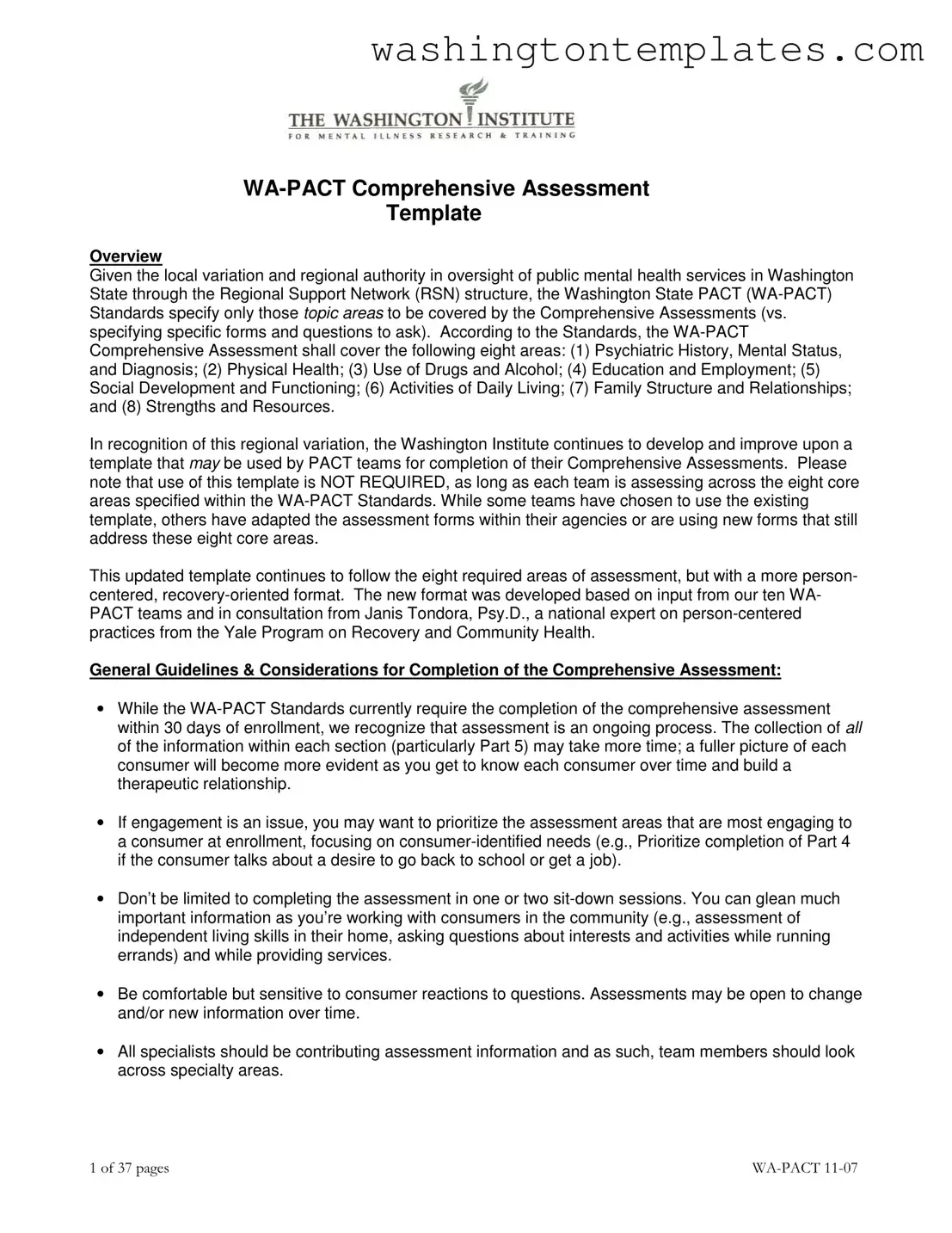WA-PACT Comprehensive Assessment
Template
Overview
Given the local variation and regional authority in oversight of public mental health services in Washington State through the Regional Support Network (RSN) structure, the Washington State PACT (WA-PACT) Standards specify only those topic areas to be covered by the Comprehensive Assessments (vs. specifying specific forms and questions to ask). According to the Standards, the WA-PACT Comprehensive Assessment shall cover the following eight areas: (1) Psychiatric History, Mental Status, and Diagnosis; (2) Physical Health; (3) Use of Drugs and Alcohol; (4) Education and Employment; (5) Social Development and Functioning; (6) Activities of Daily Living; (7) Family Structure and Relationships; and (8) Strengths and Resources.
In recognition of this regional variation, the Washington Institute continues to develop and improve upon a template that may be used by PACT teams for completion of their Comprehensive Assessments. Please note that use of this template is NOT REQUIRED, as long as each team is assessing across the eight core areas specified within the WA-PACT Standards. While some teams have chosen to use the existing template, others have adapted the assessment forms within their agencies or are using new forms that still address these eight core areas.
This updated template continues to follow the eight required areas of assessment, but with a more person- centered, recovery-oriented format. The new format was developed based on input from our ten WA- PACT teams and in consultation from Janis Tondora, Psy.D., a national expert on person-centered practices from the Yale Program on Recovery and Community Health.
General Guidelines & Considerations for Completion of the Comprehensive Assessment:
•While the WA-PACT Standards currently require the completion of the comprehensive assessment within 30 days of enrollment, we recognize that assessment is an ongoing process. The collection of all of the information within each section (particularly Part 5) may take more time; a fuller picture of each consumer will become more evident as you get to know each consumer over time and build a therapeutic relationship.
•If engagement is an issue, you may want to prioritize the assessment areas that are most engaging to a consumer at enrollment, focusing on consumer-identified needs (e.g., Prioritize completion of Part 4 if the consumer talks about a desire to go back to school or get a job).
•Don’t be limited to completing the assessment in one or two sit-down sessions. You can glean much important information as you’re working with consumers in the community (e.g., assessment of independent living skills in their home, asking questions about interests and activities while running errands) and while providing services.
•Be comfortable but sensitive to consumer reactions to questions. Assessments may be open to change and/or new information over time.
•All specialists should be contributing assessment information and as such, team members should look across specialty areas.
•Utilize client voice in direct quotes whenever possible to reflect attempts to gather information. Example: “I don’t have mental illness.” This helps ensure accuracy of assessment within the first 30 days.
Considerations for Assessing Substance Use in Part 3:
•Use assessment principles and practices consistent with Integrated Dual Disorders Treatment and Motivational Interviewing to assess consumers’ use and abuse of substances.
•In particular, remember that the first goal of substance abuse assessment within a PACT team is to facilitate an environment in which the consumer feels it is safe to talk openly with the team about substance use. Toward this end, Motivational Interviewing methods are especially helpful (e.g., using open-ended questions, using empathic and reflective statements, conveying a neutral and nonjudgmental stance).
•Specific substance abuse assessment forms, such as the Functional Analysis form and the Payoff Matrix, can be completed collaboratively with the consumer or completed initially by staff.
We hope that you find this updated template more purposeful and engaging for new PACT consumers admitted to the program.
For further questions and/or consultation on completion of the WA-PACT Comprehensive Assessment or this template, please contact Maria Monroe-DeVita, Ph.D. (206-604-5669 or mmdv@u.washington.edu) or Shannon Blajeski, MSW (206-685-0331 or blajes@u.washington.edu).
Date:
WA-PACT Comprehensive Assessment
Part 1: Mental Health & Psychiatric Symptoms
Including Psychiatric History Timeline, Mental Status, and Diagnosis
A. Mental Health & Psychiatric Symptoms
What are your most troubling psychiatric symptoms? How much do they interfere with your life? Are they getting in the way of the things you’d like to do?
How do you cope with your symptoms? What do you do to stay well? How much are your medications helping you?
If you want to make changes, what are they? What are your goals for maintaining your mental health?
What are the barriers keeping you from being as psychiatrically healthy as possible (e.g. side effects of medications, etc.)? How could the PACT team help you?
Mental Status Summary:
C. DSM IV
Axis I ______________________________________________________________
______________________________________________________________
______________________________________________________________
______________________________________________________________
Axis II ______________________________________________________________
______________________________________________________________
______________________________________________________________
Axis III _____________________________________________________________
_____________________________________________________________
_____________________________________________________________
Axis IV Primary Support |
Occupational |
Health Care |
Social Environment |
Housing |
Legal System/Crime |
Educational |
Economic |
Other _____________ |
Axis V __________ |
|
|
Assessment Summary |
|
|
Strengths/Resources
Completed by: _____________________________________ |
Date Completed: ____________ |
WA-PACT Comprehensive Assessment
Part 2: Physical Health
Do you have any specific medical problems or concerns about your health? Are you getting enough rest and exercise? If you smoke, are you interested in trying to quit?
If you want to make changes, what are they? What are your goals for staying healthy?
What are the barriers keeping you from being as healthy as possible? How could the PACT team help you with this area?
Name: __________________________________
Current Doctor and Dentist: |
|
|
|
1. |
General Physician: |
|
|
Address: |
2. |
Dentist: |
|
|
|
|
Address: |
|
|
|
|
|
|
|
|
|
|
3.Serious Illnesses and Disorders:
|
Heart disease |
Gallstones |
Diabetes |
|
|
High blood pressure |
Kidney infections |
Arthritis |
|
|
Emphysema |
Kidney stones |
Glaucoma |
|
|
Asthma |
Stomach ulcers |
Gout |
|
|
Liver disease |
Thyroid disorder |
Cancer |
|
|
Cirrhosis |
Anemia |
HIV / AIDS |
|
|
Hepatitis |
Rheumatic fever |
Other: |
|
5.Previous Medical Hospitalizations
Reason (e.g., injuries, surgery, tests and procedures)
Current Medications (non-psychiatric only)
6.List the medications taken NOW, dosage, frequency, reason for taking, when started, last date taken and prescribing physician.
Allergies |
|
7. |
Do you have any known allergies? |
Yes |
8. |
If so, describe allergies to: |
|
|
Medications |
|
|
|
|
Foods |
|
|
|
No
Hay Fever or Allergic Rhinitis Other
Family Health |
|
|
|
|
|
|
|
|
|
|
|
9. |
Father: |
Living |
Deceased |
Age, or age at death |
|
|
10. |
Mother: |
Living |
Deceased |
Age, or age at death |
|
|
11. |
Sisters: |
Number Living |
|
|
Number deceased |
|
Causes if deceased |
12. |
Brothers: |
Number living |
|
|
|
|
Number deceased |
|
Causes if deceased |
13.Children (number, names, and dates of birth/ages)
Number Deceased |
|
Causes if Deceased |







